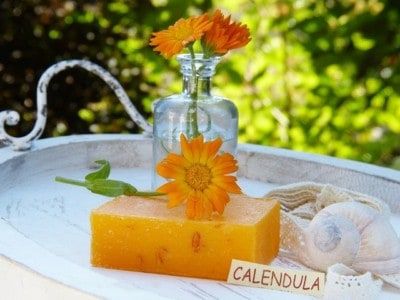Calendula and its many uses
Calendula Officinalis, commonly known as marigold or garden marigold, belongs to the daisy family and is often used to promote wound healing because of its antimicrobial and anti-inflammatory properties.
But what are the other applications of calendula? And how exactly can you use calendula? Read more in this article.
Fields of application of calendula
For wound healing
Because of its antimicrobial, wound healing and anti-inflammatory properties, calendula ointment is often used for poorly healing wounds. A tincture of calendula can also be used to clean and disinfect a wound.
For warts and corns
Calendula has also proven helpful for warts and corns in the form of a mixture of calendula leaves and vinegar. The leaves should be simply soaked in vinegar for a few days, the subsequently strained tincture can now be applied several times a day to the wart or corn.
For dry skin and neurodermatitis
Due to its anti-inflammatory effect, calendula is also suitable for soothing and regenerating the skin in cases of neurodermatitis and dry skin in general. It should be noted, however, that many neurodermatitis sufferers have a high allergy potential and may be allergic to the medicinal plant.
For acne
The anti-inflammatory properties of calendula can also benefit the fight against acne. Furthermore, it promotes blood circulation and regenerates the skin, which can eliminate acne scars.
For sunburn and burns
Treating a burn or sunburn with a calendula poultice can prevent inflammation, relieve pain and promote wound healing.
For hemorrhoids
Hemorrhoids are basically painful varicose veins of the vessels in the anal region. To prevent inflammation or bursting of these and to relieve any pain, the calendula is well and good used. It moisturizes the mucous membranes and keeps them supple.
Calendula for inflammation of the mouth and throat
For open sores and inflammations in the mouth and throat, so-called aphthae, a tea or mouth and throat rinse made from boiled marigold leaves can provide relief.
For depression and restlessness
A tea prepared from marigold leaves helps to eliminate mild depression and restlessness.
To support digestion
Calendula aids digestion, for example in cases of constipation, and can help relieve inflammation of the gastrointestinal tract, as well as soothe it. It also has a soothing effect on an irritated stomach mucosa and can eliminate possible bacterial infections
To strengthen the immune system
The flavonoids contained in marigolds contribute significantly to the strengthening and stabilization of the immune system by promoting the natural immune defenses.
Calendula in internal and external use
Internal use
– as Marigold tea:
For the preparation of a marigold tea you need only 2 teaspoons of the dried marigold leaves. It is poured over hot, no longer boiling water and left to infuse for 10 minutes before being strained.
The tea can be drunk 2 to 3 times a day, for example in case of digestive problems or restlessness. More information about marigold tea is available at https://tee-kompendium.com/marigold/.
External use
– as Calendula ointment:
To prepare calendula ointment, heat approx. 250 mL of vegetable oil, for example olive oil and add 2 whole cups of calendula flowers. After 10 to 15 minutes, strain the mixture through a gauze or linen cloth.
Then 25 g of beeswax or carnauba wax is added to the still warm oil and heated again until the wax has liquefied.
Now the ointment can be filled into boiled jars. More about calendula ointment.
– as Calendula oil:
Calendula oil can be easily made by yourself. For this one needs only some heated olive oil, which one with the freshly chopped blooms and sheets of the marigold mixes and afterwards a few days lets infuse.
Then remove the remnants of the flower by means of a sieve and store the oil in a glass jar. The marigold oil can be stored for up to two months in a light-protected place. More about the properties of marigold oil can be found at https://oelerini.com/castor-oil.
– as Marigold infusion:
To make an infusion from marigolds, pour approx. 10 marigold flowers with a liter of boiling water and let this preparation infuse for 10 minutes. The sieved infusion can now be used as a bath additive or for moist wound compresses.
– as Calendula soap:
If you want to produce marigold soap yourself, you need a suitable mold, 150 g of curd soap, 2 to 3 g of wax (for example carnauba wax), 150 mL of marigold infusion, 50 mL of the oil of marigold and three drops of any essential oil.
While the wax is melted, grind the curd soap into small pieces, a kitchen grater can be used for this purpose.
The slightly heated marigold infusion is added to the melted wax and the mixture is mixed with the soap flakes while stirring constantly. In the connection one boils up the liquid decoction once again and adds the two oils.
The last step is to fill the soap into a mold and let it harden.
– as Calendula tincture:
Marigold tincture is obtained by filling a glass half full with dried marigolds and then infusing it with at least 65% alcohol, such as brandy.
The jar should be stored tightly closed for several weeks in a light-protected and warm place before straining the tincture with the help of a filter.
